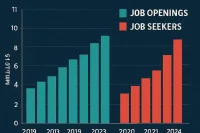Hiring in October through December — the hidden job market exposed
Hiring in October through December happens behind the scenes through the hidden job market, and HR departments hate it. A hiring manager recently exposed exactly how referrals work when there’s no published headcount—showing how candidates can get hired in just 4 days through employee referrals, completely bypassing the traditional application process. This insider perspective reveals why networking beats job applications every time, especially during the end-of-year hiring rush.
The 4-day hiring process that HR can’t control
How one candidate got hired without applying
A sales manager had plans to hire after January 1st, but no active job posting. When an employee referral came in last week, everything changed. The candidate was contacted on Monday, interviewed on Tuesday, had a formal interview on Thursday, and received an offer on Friday. This is hiring in October through December at its most efficient—no job boards, no ATS, no HR red tape.
Why hiring managers move fast for the right candidate
Companies are still hiring even without published headcount. When the right person comes along, hiring managers will create positions, get budget approval, and expedite the process. They’d rather hire someone great now than risk losing them by waiting for the “official” hiring timeline.
The hidden job market hierarchy that determines who gets hired
Priority ranking system
There’s a clear pecking order in hiring: internal applicants come first, followed by employee referrals, then sourced candidates, and finally job applicants at the bottom. Employee referrals skip the entire application process and go straight to the front of the line because they’re pre-vetted by trusted employees.
Why referrals get special treatment
Hiring managers take employee referrals seriously because they don’t want to discourage good employees from referring people. Most companies actively encourage referrals because they produce higher quality candidates who already understand the job and company culture. It’s less risky than hiring unknown applicants.
Hiring in October through December: the seasonal hiring patterns
End-of-year budget rush
Starting in September through early November, there’s usually a rush to fill final budgeted headcount before year-end. This creates a flurry of hiring activity that most job seekers miss because they’re only looking at posted jobs. The real opportunities happen through networking and referrals.
The December hiring freeze
From mid-December through mid-January, job activity comes to a screeching halt. People are on vacation, hiring managers are traveling, and it’s harder to get approvals. This dead period makes networking even more valuable—the hidden job market doesn’t stop just because job postings do.
Don’t Miss the Seasonal Hiring Window
End-of-year budget rush means October and November are prime months for hiring. Don’t wait until the December freeze slows things down—secure top talent now while the market is most active. Post your job on WhatJobs today and make the hires that set you up for success in the new year.
Post a Job Free for 30 Days →Why HR departments hate this process
The “unethical practices” complaint
One HR professional called the 4-day hiring process “unethical” and demanded that at least two more candidates be interviewed. This highlights the disconnect between HR’s box-checking mentality and hiring managers’ business-focused approach. HR wants to follow rigid processes; hiring managers want to hire the best person quickly.
The referral bias argument
HR claims that referrals are “coached” and don’t represent true skill assessment. However, hiring managers who actually do the job for a living can easily spot unqualified candidates, even with coaching. The idea that someone can be “coached up” to fool technical experts is unrealistic in most cases.
How to leverage hiring in October through December
Build targeted company relationships
Instead of applying to posted jobs, focus on building relationships with people at your target companies. Ask about future hiring plans, upcoming projects, or team expansion. Most employees know about hiring plans months before jobs are posted.
Create referral opportunities
Make it easy for employees to refer you by being specific about your value proposition. Share your resume, highlight relevant experience, and explain how you could contribute to their team. The best referrals happen when employees can clearly articulate why you’d be a good fit.
The networking advantage in hidden job market
Skip the application process entirely
Employee referrals bypass recruiters, ATS systems, and the entire application process. You go straight to the hiring manager, who has already been pre-sold on your candidacy by a trusted employee. This eliminates most of the competition and red tape.
Faster decision-making
When hiring managers find the right candidate through referrals, they can move quickly without waiting for HR processes. They’ll create headcount, get budget approval, and make offers before competitors can react. Speed is a major advantage in the hidden job market.
Why traditional job applications fail during hiring in October through December
You’re competing with thousands
Posted jobs receive hundreds or thousands of applications, putting you at the bottom of the priority list. Even if you’re qualified, you’re just one application in a massive bucket. Referrals skip this entire competition.
HR processes slow everything down
Traditional hiring requires multiple interviews, assessments, background checks, and approval processes. By the time HR completes their requirements, the best candidates have often moved on to other opportunities or been hired through referrals.
How to become the candidate that forces immediate hiring
Demonstrate immediate value
Show hiring managers that you’re worth hiring now rather than waiting for their planned timeline. Highlight specific skills, experience, or results that directly address their current challenges. Make them think, “We need this person immediately.”
Create urgency through scarcity
Let them know you’re considering other opportunities or have a timeline. This creates urgency that can accelerate their hiring process. The best candidates don’t wait around for companies to get their act together.
Hiring in October through December: what HR doesn’t want you to know
Most hiring happens off the books
Companies hire people for roles that don’t exist yet, create positions for exceptional candidates, and expedite processes when they find the right person. This happens constantly, but it’s not reflected in job posting statistics.
Networking beats applications every time
Employee referrals have a higher success rate than job applications because they’re pre-vetted and trusted. The person referring you has already done the initial screening and is putting their reputation on the line.
FAQs
Q: Why is hiring in October through December different from other times?
A: Companies rush to fill budgeted headcount before year-end, creating opportunities for quick hires through referrals. The hidden job market is most active during this period.
Q: How does hiring in October through December work through referrals?
A: Employee referrals skip the application process entirely, going straight to hiring managers who can create positions and expedite offers for the right candidates.
Q: Why do HR departments hate hiring in October through December processes?
A: HR wants rigid processes with multiple interviews and box-checking, while hiring managers prefer to hire the best candidate quickly when they find them.
Q: How can I leverage hiring in October through December for my job search?
A: Build relationships with employees at target companies, ask about future hiring plans, and make it easy for them to refer you by clearly articulating your value proposition.
Live example — user point of view
I was struggling with hiring in October through December until I changed my approach. Instead of applying to posted jobs, I reached out to a former colleague who worked at my dream company. I asked about their team’s challenges and shared how I’d solved similar problems. Two weeks later, he referred me for a role that wasn’t even posted yet. I interviewed on Tuesday, got an offer on Friday, and started the following Monday—all before the job was officially posted. The hiring manager said they created the position specifically for me because I was the right fit. Networking beat applications every time.




